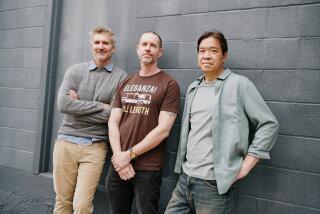The Three-Pound Universe<i> by Judith Hooper and Dick Teresi (Macmillan: $19.95; 288 pp., illustrated) </i> : Megabrain: <i> New Tools and Techniques for Brain Growth and Mind Expansion : by Michael Hutchison (Beech Tree/Morrow: $17.95; 341 pp., illustrated) </i>
- Share via
Books about the brain are written for many purposes. Some are texts--often technical and foreboding--that educate new generations of students in the science of brain research. Others are intended for a more general audience, individuals who are simply interested in the workings of this most mysterious organ that gives each of us the essence of our humanness. Judith Hooper and Dick Teresi’s “The Three-Pound Universe” and Michael Hutchinson’s “Megabrain” are new books intended for the general reader; each is concerned with the relation between mind and brain, but in very different ways.
“Without the brain,” write Hooper and Teresi, “nothing--not quarks, not black holes, nor love, nor hatred--would exist for us. The universe exists for us only insofar as it exists in our brains. The brain is our three-pound universe.” Understanding the brain, protected as it is by the bony fortress of the skull, is one of the most difficult tasks facing modern science. Yet advances are occurring rapidly. As Hooper and Teresi observe: “This is the Brain Age. The 1930s and 1940s were the golden age of physics. The next two decades saw the flowering of molecular biology. But the great frontier of the 1980s is neuroscience.”
Neuroscience is a relatively new term that reflects the interdisciplinary nature of brain research. The practitioners of neuroscience include anatomists, physiologists, psychologists, chemists, engineers, and a spattering of linguists, ethologists, and other species of scientific specialists. It is this frontier of neuroscience that Hooper and Teresi explore in their enchanting and lively book. Always engaging and accessible, the authors--both editors of Omni magazine--have done a masterful job of tracking down a number of eminent brain scientists and of reporting their findings in a remarkably clear and entertaining manner. They remain accurate and true to the science, even when issues become complex. The result is a book that is enjoyable and informative.
“The Three-Pound Universe” is built upon a series of conversations between the authors and the neuroscientists. Through these conversations we learn many things. We are introduced to the “designer drugs,” which exert very powerful and specific influences upon the nervous system; these are newly synthesized compounds that either mimic or block the chemicals that the brain uses in its normal workings. We follow the search for anti-anxiety drugs and their opposite, chemicals that induce fear and terror. We witness the heavens and hells that can be produced by electrical stimulation of particular regions of the brain using surgically implanted electrodes. We, like the neuroscientists, are puzzled by the brain-twisting psychotic disorders, such as schizophrenia, and are intrigued by the idea that this mind-crippling disease may be the result of an ordinary virus. We are shown the almost unbelievable images produced by the newly developed brain scanners and other engineering achievements that are revolutionizing neuroscience research. In its 14 chapters, “The Three-Pound Universe” conveys both the excitement and promise of contemporary brain research.
With a scope so broad, there is a danger that the reader could lose interest or direction, but such is not the case here. The casual conversational style of the narrative and the frequent quotations make Hooper and Teresi’s book extraordinarily readable. “The Three-Pound Universe” will be enjoyed by those who appreciate Nova or Scientific American.
Hutchison’s “Megabrain” is a very different book. Hutchison is interested in “mind expansion,” and his book chronicles his personal quest for a machine that will “stimulate the brain and enhance mental functioning.” Such machines are not the miracles of modern neuroscience, but rather home-built devices of uncertain value. “Anyone who knows a bit of electronics,” says the inventor of one such machine, “could put it together with about nineteen dollars worth of parts from Radio Shack.”
The characters that we meet on Hutchison’s journey are not the neuroscientists of Hooper and Teresi, but rather isolated inventors and hopeful businessmen. Hutchison recognizes the chancy nature of some of these enterprises. (“It was lunacy. But it was damned interesting lunacy, and I was eager to hear more.”) Writing in a breathless style (with such chapter titles as “In search of the wild mind machine” and “We sing the mind electric”), the author seems enraptured with the “brain boosters” that he tries. The critical reader, however, cannot share this excitement; as Hutchison correctly notes, there is little hard evidence that any of these devices has any real effect on either mind or brain.
Progress in science, including neuroscience, is based upon good thinking coupled with careful experimental testing: After all, not all “good” ideas can possibly be correct. “The Three-Pound Universe” provides enriching views of current thinking about the human brain, views that will undoubtedly change in the light of future experimentation. “Megabrain” illustrates what can happen when rigorous experimentation is ignored and tantalizing promises are pursued without confirming evidence.





